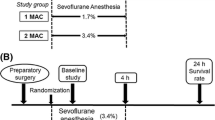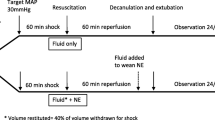Abstract
Classical experimental models of hemorrhage are characterized by the use of anesthetics that may interfere with the typical immune responses and pathology of hemorrhage/resuscitation. Thus, therapeutic strategies successful in anesthetized animals might not be beneficial in clinical trials. In this study, we analyzed whether ethyl pyruvate could provide therapeutic benefits during resuscitation in awake (unanesthetized) hemorrhage. Our results indicate that hemorrhage in unanesthetized animals required approximately 25% higher blood withdrawal than anesthetized animals to achieve the same targeted mean arterial blood pressure. Resuscitation with Hextend reestablished circulatory volume and improved survival during resuscitation of awake rodents. Yet, over 75% of the animals resuscitated with Hextend died within the first hours after hemorrhage. Resuscitation with Hextend containing 50 mM ethyl pyruvate protected over 87% of the animals. This survival benefit did not correlate with significant changes in the metabolic markers but with an anti-inflammatory potential during resuscitation. Unlike classical hemorrhage in anesthetized animals, ethyl pyruvate reestablished mean arterial blood pressure significantly earlier than Hextend in unanesthetized rodents. Unanesthetized animals showed twofold higher serum tumor necrosis factor (TNF)-α than anesthetized animals subjected to the same blood pressure. This process was not due to the response of a single organ, but affected all the analyzed organs including the lung, heart, spleen, and liver. Although resuscitation with Hextend failed to attenuate systemic TNF-α levels, it inhibited TNF-α levels in the lung, heart, and liver but not in the spleen. Unlike Hextend, resuscitation with ethyl pyruvate prevented high serum TNF-α levels and blunted TNF-α responses in all the organs including the spleen. These studies indicate that the inflammatory responses in anesthetized animals differ from that in unanesthetized animals and that awake hemorrhage can provide advantages in the study of anti-inflammatory strategies during resuscitation. Ethyl pyruvate may attenuate systemic inflammatory responses during resuscitation and improve survival in experimental models of awake hemorrhage.






Similar content being viewed by others
References
Mannucci PM, Levi M (2007) Prevention and treatment of major blood loss. N Engl J Med 356:2301–2311
Rushing GD, Britt LD (2008) Reperfusion injury after hemorrhage: a collective review. Ann Surg 247:929–937
Ulloa L, Tracey KJ (2005) The “cytokine profile”: a code for sepsis. Trends Mol Med 11:56–63
Ulloa L (2005) The vagus nerve and the nicotinic anti-inflammatory pathway. Nat Rev Drug Discov 4:673–684
Tracey KJ, Cerami A (1993) Tumor necrosis factor, other cytokines and disease. Annu Rev Cell Biol 9:317–343
Tracey KJ, Cerami A (1994) Tumor necrosis factor: a pleiotropic cytokine and therapeutic target. Annu Rev Med 45:491–503
Gan TJ, Bennett-Guerrero E, Phillips-Bute B, Wakeling H, Moskowitz DM, Olufolabi Y, Konstadt SN, Bradford C, Glass PS, Machin SJ, Mythen MG (1999) Hextend, a physiologically balanced plasma expander for large volume use in major surgery: a randomized phase III clinical trial. Hextend Study Group. Anesth Analg 88:992–998
Nielsen VG, Tan S, Brix AE, Baird MS, Parks DA (1997) Hextend (hetastarch solution) decreases multiple organ injury and xanthine oxidase release after hepatoenteric ischemia–reperfusion in rabbits. Crit Care Med 25:1565–1574
Kellum JA (2002) Fluid resuscitation and hyperchloremic acidosis in experimental sepsis: improved short-term survival and acid–base balance with Hextend compared with saline. Crit Care Med 30:300–305
Handrigan MT, Bentley TB, Oliver JD, Tabaku LS, Burge JR, Atkins JL (2005) Choice of fluid influences outcome in prolonged hypotensive resuscitation after hemorrhage in awake rats. Shock 23:337–343
Mapstone J, Roberts I, Evans P (2003) Fluid resuscitation strategies: a systematic review of animal trials. J Trauma 55:571–589
Cordell AR (1995) Milestones in the development of cardioplegia. Ann Thorac Surg 60:793–796
Baskett TF (2003) The resuscitation greats: Sydney Ringer and lactated Ringer’s solution. Resuscitation 58:5–7
Montgomery CM, Fairhurst AS, Webb JL (1956) Metabolic studies on heart mitochondria. III. The action of parapyruvate on −α-ketoglutaric oxidase. J Biol Chem 221:369–376
Slovin PN, Huang CJ, Cade JR, Wood CE, Nasiroglu O, Privette M, Orbach P, Skimming JW (2001) Sodium pyruvate is better than sodium chloride as a resuscitation solution in a rodent model of profound hemorrhagic shock. Resuscitation 50:109–115
Vonkorff RW (1964) Pyruvate-C14, purity and stability. Anal Biochem 8:171–178
Fink MP (2008) Ethyl pyruvate. Curr Opin Anaesthesiol 21:160–167
Ulloa L, Ochani M, Yang H, Tanovic M, Halperin D, Yang R, Czura CJ, Fink MP, Tracey KJ (2002) Ethyl pyruvate prevents lethality in mice with established lethal sepsis and systemic inflammation. Proc Natl Acad Sci U S A 99:12351–12356
Ulloa L, Fink MP, Tracey KJ (2003) Ethyl pyruvate protects against lethal systemic inflammation by preventing HMGB1 release. Ann NY Acad Sci 987:319–321
Tawadrous ZS, Delude RL, Fink MP (2002) Resuscitation from hemorrhagic shock with Ringer’s ethyl pyruvate solution improves survival and ameliorates intestinal mucosal hyperpermeability in rats. Shock 17:473–477
Yang R, Gallo DJ, Baust JJ, Uchiyama T, Watkins SK, Delude RL, Fink MP (2002) Ethyl pyruvate modulates inflammatory gene expression in mice subjected to hemorrhagic shock. Am J Physiol Gastrointest Liver Physiol 283:G212–G221
Mulier KE, Beilman GJ, Conroy MJ, Taylor JH, Skarda DE, Hammer BE (2005) Ringer’s ethyl pyruvate in hemorrhagic shock and resuscitation does not improve early hemodynamics or tissue energetics. Shock 23:248–252
Sappington PL, Cruz RJ Jr., Harada T, Yang R, Han Y, Englert JA, Ajami AA, Killeen ME, Delude RL, Fink MP (2005) The ethyl pyruvate analogues, diethyl oxaloproprionate, 2-acetamidoacrylate, and methyl-2-acetamidoacrylate, exhibit anti-inflammatory properties in vivo and/or in vitro. Biochem Pharmacol 70:1579–1592
Su F, Wang Z, Cai Y, Remmelink M, Vincent JL (2007) Beneficial effects of ethyl pyruvate in septic shock from peritonitis. Arch Surg 142:166–171
Riedemann NC, Guo RF, Ward PA (2003) Novel strategies for the treatment of sepsis. Nat Med 9:517–524
Su J, Li X, Cui X, Li Y, Fitz Y, Hsu L, Mani H, Quezado M, Eichacker PQ (2008) Ethyl pyruvate decreased early nuclear factor-kappaB levels but worsened survival in lipopolysaccharide-challenged mice. Crit Care Med 36:1059–1067
Tenhunen JJ (2008) Bull’s eye missed by the magic bullet: preclinical investigations, publication bias, and promising new interventions. Crit Care Med 36:1361–1363
Peterson BT, Miller EJ, Griffith DE, Rowjee R, McWaters P (2000) Modulation by pentobarbital of neutrophil responses to inhaled E. coli endotoxin in sheep: role of lung epithelium. Eur Respir J 16:697–703
Wang J, Charboneau R, Balasubramanian S, Barke RA, Loh HH, Roy S (2002) The immunosuppressive effects of chronic morphine treatment are partially dependent on corticosterone and mediated by the mu-opioid receptor. J Leukoc Biol 71:782–790
Giassi LJ, Poynter AK, Gainer JL (2002) Trans sodium crocetinate for hemorrhagic shock: effect of time delay in initiating therapy. Shock 18:585–588
Wu CH, Bogusky RT, Holcroft JW, Kramer GC (1988) NMR monitoring of phosphate metabolism of rat skeletal muscle during hemorrhage and resuscitation. J Trauma 28:757–764
Cai B, Chen F, Lin X, Levente K, Miller EJ, Szabo C, Deitch E, Ulloa L (2009) Anti-inflammatory adjuvant in resuscitation fluids improves survival in hemorrhage. Crit Care Med (in press)
Ditsworth D, Zong WX, Thompson CB (2007) Activation of poly(ADP)-ribose polymerase (PARP-1) induces release of the pro-inflammatory mediator HMGB1 from the nucleus. J Biol Chem 282:17845–17854
Szabo C (1998) Potential role of the peroxynitrate-poly(ADP-ribose) synthetase pathway in a rat model of severe hemorrhagic shock. Shock 9:341–344
Virag L, Szabo C (2002) The therapeutic potential of poly(ADP-ribose) polymerase inhibitors. Pharmacol Rev 54:375–429
Jagtap P, Szabo C (2005) Poly(ADP-ribose) polymerase and the therapeutic effects of its inhibitors. Nat Rev Drug Discov 4:421–440
Stern SA, Dronen SC, Birrer P, Wang X (1993) Effect of blood pressure on hemorrhage volume and survival in a near-fatal hemorrhage model incorporating a vascular injury. Ann Emerg Med 22:155–163
Institute of Medicine Committee on Fluid Resuscitation for Combat Casualties (1999) Protocols of care at the cite of injury. D. N. A. P., Washington, pp 97–108
House SD, Mao X, Wu G, Espinelli D, Li WX, Chang SL (2001) Chronic morphine potentiates the inflammatory response by disrupting interleukin-1beta modulation of the hypothalamic–pituitary–adrenal axis. J Neuroimmunol 118:277–285
Singhal PC, Bhaskaran M, Patel J, Patel K, Kasinath BS, Duraisamy S, Franki N, Reddy K, Kapasi AA (2002) Role of p38 mitogen-activated protein kinase phosphorylation and Fas–Fas ligand interaction in morphine-induced macrophage apoptosis. J Immunol 168:4025–4033
Malik AA, Radhakrishnan N, Reddy K, Smith AD, Singhal PC (2002) Morphine-induced macrophage apoptosis modulates migration of macrophages: use of in vitro model of urinary tract infection. J Endourol 16:605–610
Huston JM, Ochani M, Rosas-Ballina M, Liao H, Ochani K, Pavlov VA, Gallowitsch-Puerta M, Ashok M, Czura CJ, Foxwell B, Tracey KJ, Ulloa L (2006) Splenectomy inactivates the cholinergic antiinflammatory pathway during lethal endotoxemia and polymicrobial sepsis. J Exp Med 203:1623–1628
Han Y, Englert JA, Yang R, Delude RL, Fink MP (2005) Ethyl pyruvate inhibits nuclear factor-kappaB-dependent signaling by directly targeting p65. J Pharmacol Exp Ther 312:1097–1105
Liaudet L, Soriano FG, Szabo E, Virag L, Mabley JG, Salzman AL, Szabo C (2000) Protection against hemorrhagic shock in mice genetically deficient in poly(ADP-ribose)polymerase. Proc Natl Acad Sci U S A 97:10203–10208
Woo YJ, Taylor MD, Cohen JE, Jayasankar V, Bish LT, Burdick J, Pirolli TJ, Berry MF, Hsu V, Grand T (2004) Ethyl pyruvate preserves cardiac function and attenuates oxidative injury after prolonged myocardial ischemia. J Thorac Cardiovasc Surg 127:1262–1269
Baeuerle PA, Henkel T (1994) Function and activation of NF-kappa B in the immune system. Annu Rev Immunol 12:141–179
Li Q, Verma IM (2002) NF-kappaB regulation in the immune system. Nat Rev Immunol 2:725–734
Hayden MS, West AP, Ghosh S (2006) NF-kappaB and the immune response. Oncogene 25:6758–6780
Li ZW, Chu W, Hu Y, Delhase M, Deerinck T, Ellisman M, Johnson R, Karin M (1999) The IKKbeta subunit of IkappaB kinase (IKK) is essential for nuclear factor kappaB activation and prevention of apoptosis. J Exp Med 189:1839–1845
Li Q, Van Antwerp D, Mercurio F, Lee KF, Verma IM (1999) Severe liver degeneration in mice lacking the IkappaB kinase 2 gene. Science 284:321–325
Tanaka M, Fuentes ME, Yamaguchi K, Durnin MH, Dalrymple SA, Hardy KL, Goeddel DV (1999) Embryonic lethality, liver degeneration, and impaired NF-kappa B activation in IKK-beta-deficient mice. Immunity 10:421–429
Beg AA, Sha WC, Bronson RT, Ghosh S, Baltimore D (1995) Embryonic lethality and liver degeneration in mice lacking the RelA component of NF-kappa B. Nature 376:167–170
Alcamo E, Hacohen N, Schulte LC, Rennert PD, Hynes RO, Baltimore D (2002) Requirement for the NF-kappaB family member RelA in the development of secondary lymphoid organs. J Exp Med 195:233–244
Doi TS, Marino MW, Takahashi T, Yoshida T, Sakakura T, Old LJ, Obata Y (1999) Absence of tumor necrosis factor rescues RelA-deficient mice from embryonic lethality. Proc Natl Acad Sci U S A 96:2994–2999
Mantell LL, Parrish WR, Ulloa L (2006) HMGB1 as a therapeutic target for infectious and inflammatory disorders. Shock 25:4–11
Acknowledgments
LU is supported by the faculty program of the Department of Surgery of the New Jersey Medical School, and grants from the US Army Medical Research Command (USAMRMC#05308004), the American Heart Association (AHA06352230N), and the NIH (RO1-GM084125).
Author information
Authors and Affiliations
Corresponding author
Rights and permissions
About this article
Cite this article
Cai, B., Brunner, M., Wang, H. et al. Ethyl pyruvate improves survival in awake hemorrhage. J Mol Med 87, 423–433 (2009). https://doi.org/10.1007/s00109-009-0441-8
Received:
Revised:
Accepted:
Published:
Issue Date:
DOI: https://doi.org/10.1007/s00109-009-0441-8




